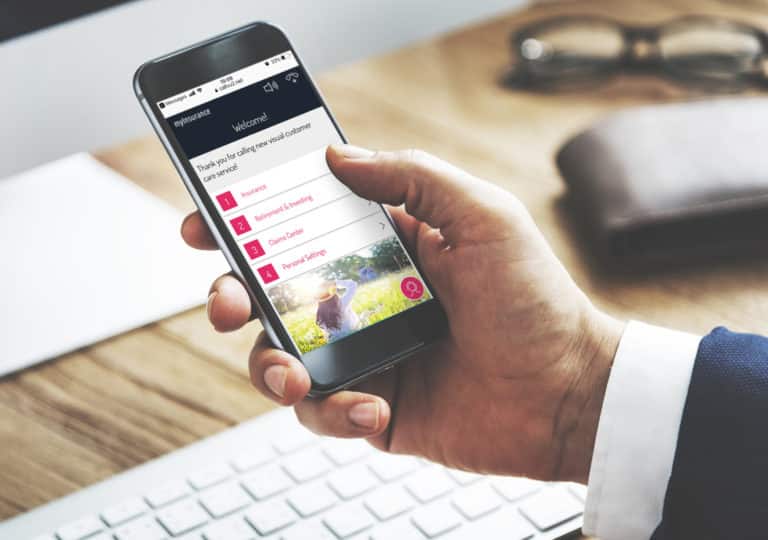Many companies want to build digital self-service experiences to replace manual and broken customer processes. Digital processes reflect changing consumer expectations and preferences — many people want a self-service option the tasks they must complete when interacting with your brand.
All the teams in your org focused on customer-facing engagement (Innovation, Customer Experience, Customer Care, Contact Center, Development, Digital, and Sales) recognize that self-service experiences give customers faster and easier ways to complete actions and answer common questions. They also dramatically reduce business service costs versus contact center interactions, retail/branch visits, or processes that involve paper or PDFs.
All that is the good news. The problem is that most organizations struggle to build digital self-service experiences at the pace they want. Limited dev resources, knowledge base gaps, long dev queues, and systems integration challenges all contribute to delays and high costs.
The No-Code Alternative
Fortunately, a new type of experience development solution is now available: no-code CX automation. No-code platforms enable anyone to build powerful “last-mile” customer experiences without knowing code. Straightforward workflows and an easy-to-use platform come together to give “citizen developers” the power to create highly secure omnichannel customer applications that incorporate things like:
- Digital Forms
- ID Verification
- Auto-Fill
- Video Chat Co-Browsing Chatbots
- Document Sharing
- Multimedia
- E-Signature
- Content Uploads
- PCI Payments
Pre-built and API-based integrations make it easy to connect these experiences with your company’s existing CRM, account management, call center, and other systems. No rip-and-replace. Then, using these same platforms, you can deploy these digital self-service experiences across all channels – websites, customer self-service portals, apps, call centers, and retail/branch locations.
Great no-code CX automation platforms don’t stop with the customer-facing components. Digital self-service works best when the internal steps for the process are also automated. For example, a bank can use its no-code CX automation platform to route data, forward completed applications for review, request signatures/sign-off, and authorize fund transfers. It’s all about speeding processes and driving higher customer satisfaction.
No-code is revolutionizing CX automation and development. But while lots of people are intrigued by the reported speed and cost-effectiveness of this approach, they are unclear how a layperson can manage the dev and deployment process. This post lays it out step by step.
Step One: Problem identification
Your first step to build digital self-service experiences is to outline the customer experience you want to automate. Most companies begin using no-code CX tools by first digitizing a ubiquitous but manual or broken process. For example:
- Banks automate loan applications and onboarding
- Insurance companies digitize claims and new policy underwriting
- Telecom companies automate their sign-up and bill payment workflows
Identify the process/issue you want to solve. What self-service customer support and sales experiences would eliminate customer friction and boost satisfaction? List each step in both the customer experience and the internal process milestones. Here are a few questions to consider:
- What will be the outcome of the process?
- What do we need to get us there?
- What internal processes do we need to automate?
- Where does data need to come from/go to (platforms)?
- In which channels should we deploy the new customer experience?
A little tip: As you think about deployment channels, consider how your self-serve process might help an agent complete a process more quickly if someone decides to call. Remember that you can incorporate screen sharing and forms into call center workflows to cut AHT and ensure more accurate data.
As you examine each digital customer experience step, think through the sources of friction – complex steps, unnecessary delays, data re-entry, and the like. Solutions for each of these elements can become part of your plan as you build digital self-service experiences and process flows.
Step Two: Architect the Process
Then it’s time to map out the process for development in your digital self-service development platform. The right tool makes it easy to layout these steps with nodes-based workflow mapping. For many processes, this mapping can be a D-I-Y affair using a robust Digital CX offering. When things get more complicated, it can be helpful to have a partner team to enlist. With FICX, our internal team can use its vast experience to create a comprehensive process flow. This support service comes at no additional charge to our clients.
Step Three: Build the Process
The next step is to build the interface of the digital self-service experience itself. No-code platforms make creating inviting and intuitive experiences relatively straightforward. The FICX No-Code CX Automation Platform, for example, offers a drag and drop UI that anyone can use to build forms and other screens for a rich and satisfying experience.
With FICX, users have the choice of starting their experience from scratch or using a pre-built experience as a foundation. Either way, the user can fully customize to meet the specific needs of their process. Adding capabilities like video chat, conversational AI chatbots, and e-signature is also simple; FICX offers native solutions for many essential tasks, or you can “bring your own” third-party solutions.
Great platforms also enable you to brand your experience so that the look and feel are consistent with all other company interactions. Once you have completed your experience, you can share it with internal stakeholders and make additional changes.
Step Four: Connect to Systems
Any solution should easily connect your front-end digital self-service experiences with the underlying platforms and data required to complete the desired actions. You don’t have no-code if you must extensively involve developers to integrate with internal platforms. Integrations are often the most time-consuming components of experience development.
A great system integrates your existing systems seamlessly. No rip-and-replace. FICX, for example, offers pre-built and API-based integrations with any other platform, including ERP. If a company has a home-grown platform, our highly experienced integrations team will build a bespoke integration at no additional cost to the customer.
One thing to remember is that platform and experience needs often require two-way data exchange. Data collected by the digital self-service experience should flow in real-time to all relevant company platforms. Additionally, by accessing platform data, experiences can offer form pre-fill and personalized experiences to customers.
Step Five: Deploy in Appropriate Channels
Once your experience is integrated into your company systems and processes, you are ready to deploy. The best no-code solutions enable you to leverage a digital self-service single experience across all customer touchpoints, be they on the web, in mobile apps, as part of contact center workflows, and even at retail/in branches.
Think carefully before you limit an experience to a single channel. Through their daily interactions with Google, social media networks, email, and other applications, customers have become accustomed to accessing an experience whenever and wherever they want. A great customer experience can adapt to any screen or use case. Customers also expect to start an experience on one screen and later finish it on another. Your experiences should offer the same universal experience.
The FICX platform, for example, creates experiences that can be deployed across channels for maximum value to the customer and the business. We are renowned for how our digital self-service experiences also adapt to call center use cases. They are outstanding for helping a customer service representative help customers at any stage of a customer journey.
While it may seem counterintuitive to deploy digital self-service applications in a call center, they can be very helpful in maximizing FCR and reducing AHT. Support team agents can use them to collect data or activate co-browsing and content sharing sessions and assist customers in completing the steps. Time saved is money saved here and also helps maximize support agent and customer satisfaction.
Step Six: Measure and Optimize
When you deploy, it’s essential to measure the effectiveness of your experience to ensure you have achieved your objectives. A robust platform, like FICX, provides native measurement of key metrics in real-time, along with power data visualizations. Using this data, you can test alternative versions of an experience or make small changes to reduce friction further and maximize compliance.
Here’s a screenshot of the FICX platform to demonstrate the quality and depth of available data.
Conclusions
As you have seen, a robust no-code CX automation platform, coupled with a proven development and employment process, offers tremendous advantages versus custom development. It makes delivering a strong self-service customer support strategy faster and easier. Across a broad range of FICX clients, no-code CX reduces timelines and costs by 90+% over custom application development. Whether your role is in CX, innovation, or a line management function, no-code offers an incredible value with no losses in quality, customer satisfaction, or security.
As you explore your options for no-code CX, please consider FICX. At FICX, we focus on ensuring that customers get a great experience with your brand and company in whatever way they choose to interact. Offering customers more self customer service solutions yields outstanding dividends and can have a tremendously positive impact on the overall brand experience.
Our company has been working with contact centers and omnichannel CX professionals for many. We focus on ensuring customers have the best strategies and tactics to improve their cx experiences. Happy customers, lower costs, and outstanding customer feedback. For more information on FICX and our solutions, visit our site and request a demo.





